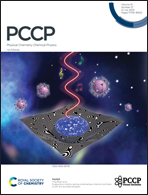Adsorption mechanism of the N2 and NRR intermediates on oxygen modified MnN4–graphene layers – a single atom catalysis perspective†
Abstract
In the present work the adsorption of N2 and the nitrogen reduction reaction (NRR) intermediates have been investigated on oxygen modified MnNxOy (x + y = 4, x ≠ 0)/graphene layers through periodic density functional theory calculations. Various number of oxygen atoms substitute nitrogen atoms within the MnNxOy, with their effect on the layer stability, chemical bonding and N2 adsorption being explored. As the oxygen amount increases in the porphyrin unit, Mn–O interactions weaken with reference to that of Mn–N, bonding orbitals become less populated while the antibonding orbitals between Mn–N–O atoms become partially occupied, as evidenced by the Crystal orbital Hamiltonian population (COHP) and integrated crystal orbital bond index (ICOBI) analyses. During N2 adsorption on the different layers, the substitution of two and three nitrogen atoms by oxygen leads to the longest N![[triple bond, length as m-dash]](https://www.rsc.org/images/entities/char_e002.gif) N molecular bond length. Two main orientations for the N2 molecules sorption have been investigated: side-on and end-on which are perpendicular and parallel to the surface normal, respectively. When the interaction of N2 with MnNO3 layer is considered, d-band center variation of the Mn with reference to the pre-adsorbed state is more obvious after side-on adsorption configuration. For the selected layers based on initial N2 adsorption energies, the adsorption energies of nitrogen reduction reaction intermediates follow a trend based on the number of oxygen atoms in the porphyrin units. Charge density difference (CDD) maps and partial density of states (PDOS) analysis reveal that the interaction of N2 with oxygen modified layers takes place through electron acception–donation mechanism between the partially occupied Mn-d orbitals and the 2p orbitals of the N2 molecule. DDEC6-derived bond orders and atomic charges support the PDOS and adsorption/formation energy trends, and further clarify the bonding strengths of the atoms in the porphyrin units, as well as the Mn–N2 interactions in the adsorbed systems.
N molecular bond length. Two main orientations for the N2 molecules sorption have been investigated: side-on and end-on which are perpendicular and parallel to the surface normal, respectively. When the interaction of N2 with MnNO3 layer is considered, d-band center variation of the Mn with reference to the pre-adsorbed state is more obvious after side-on adsorption configuration. For the selected layers based on initial N2 adsorption energies, the adsorption energies of nitrogen reduction reaction intermediates follow a trend based on the number of oxygen atoms in the porphyrin units. Charge density difference (CDD) maps and partial density of states (PDOS) analysis reveal that the interaction of N2 with oxygen modified layers takes place through electron acception–donation mechanism between the partially occupied Mn-d orbitals and the 2p orbitals of the N2 molecule. DDEC6-derived bond orders and atomic charges support the PDOS and adsorption/formation energy trends, and further clarify the bonding strengths of the atoms in the porphyrin units, as well as the Mn–N2 interactions in the adsorbed systems.



 Please wait while we load your content...
Please wait while we load your content...